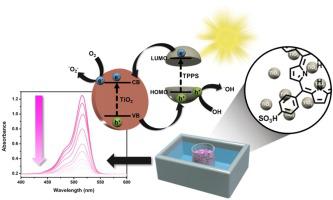当前位置:
X-MOL 学术
›
Colloids Surf. A Physicochem. Eng. Aspects
›
论文详情
Our official English website, www.x-mol.net, welcomes your
feedback! (Note: you will need to create a separate account there.)
Photo discoloration of eosin yellow dye under visible light using TiO2@TPPS nanocomposite synthesized via ultrasonic assisted method
Colloids and Surfaces A: Physicochemical and Engineering Aspects ( IF 4.9 ) Pub Date : 2021-01-01 , DOI: 10.1016/j.colsurfa.2020.125601 Ramalingam Manivannan , Jiwon Ryu , Young-A. Son
Colloids and Surfaces A: Physicochemical and Engineering Aspects ( IF 4.9 ) Pub Date : 2021-01-01 , DOI: 10.1016/j.colsurfa.2020.125601 Ramalingam Manivannan , Jiwon Ryu , Young-A. Son

|
Abstract This paper describes a new TiO2@TPPS (titanium dioxide @ tetraphenyl-porphyrin sulfonic acid) nanocomposite synthesized via ultrasonic assisted method using a bath-type ultrasonicator at 20 kHz (ultrasonic frequency) and 100 W (ultrasonic power). XRD (X-ray diffraction), FT-IR (Fourier-transform infrared spectroscopy), XPS (X-ray photoelectron spectroscopy), SEM (Scanning electron microscope), EDX (Energy-dispersive X-ray spectroscopy), and UV-DRS (Ultraviolet-visible spectroscopy) were used to systematically characterize the nanocomposite. Compared to TiO2, the TiO2@TPPS nanocomposite obviously exhibits higher photocatalytic activity towards EY (eosin yellow) dye degradation. The optimized weight ratio of 0.1 g of TiO2 nanosphere and 0.01 g of TPPS resulted in efficient discoloration of EY. The EY discoloration was 99 % within 50 min under visible light in the presence of the TiO2@TPPS nanocomposite. Additionally, the nanocomposite catalysts are highly stable and reusable for five consecutive experiments. This performance can be attributed to the synergistic effect of TiO2 and TPPS, which enhanced the charge separation and reduced the rate of recombination. The photodegradation mechanism was also investigated and discussed. It is expected that our work can offer a new way to develop binary nanocomposites with visible-region adsorption for photocatalytic discoloration of organic pollutants and energy applications.
中文翻译:

超声辅助合成的TiO2@TPPS纳米复合材料在可见光下对曙红黄染料进行光变色
摘要 本文描述了一种新型 TiO2@TPPS(二氧化钛@四苯基卟啉磺酸)纳米复合材料,采用超声波辅助方法,使用浴式超声波发生器,频率为 20 kHz(超声波频率)和 100 W(超声波功率)。XRD(X 射线衍射)、FT-IR(傅里叶变换红外光谱)、XPS(X 射线光电子能谱)、SEM(扫描电子显微镜)、EDX(能量色散 X 射线光谱)和 UV-DRS (紫外-可见光谱)用于系统地表征纳米复合材料。与 TiO2 相比,TiO2@TPPS 纳米复合材料明显对 EY(曙红黄)染料降解表现出更高的光催化活性。0.1 克 TiO2 纳米球和 0.01 克 TPPS 的优化重量比导致 EY 有效变色。在 TiO2@TPPS 纳米复合材料的存在下,在可见光下 50 分钟内 EY 变色为 99%。此外,纳米复合催化剂高度稳定,可重复使用五次连续实验。这种性能可归因于 TiO2 和 TPPS 的协同作用,增强了电荷分离并降低了复合率。还研究和讨论了光降解机制。预计我们的工作可以提供一种新的方法来开发具有可见光区吸附的二元纳米复合材料,用于有机污染物的光催化变色和能源应用。这种性能可归因于 TiO2 和 TPPS 的协同作用,增强了电荷分离并降低了复合率。还研究和讨论了光降解机制。预计我们的工作可以提供一种新的方法来开发具有可见光区吸附的二元纳米复合材料,用于有机污染物的光催化变色和能源应用。这种性能可归因于 TiO2 和 TPPS 的协同作用,增强了电荷分离并降低了复合率。还研究和讨论了光降解机制。预计我们的工作可以提供一种新的方法来开发具有可见光区吸附的二元纳米复合材料,用于有机污染物的光催化变色和能源应用。
更新日期:2021-01-01
中文翻译:

超声辅助合成的TiO2@TPPS纳米复合材料在可见光下对曙红黄染料进行光变色
摘要 本文描述了一种新型 TiO2@TPPS(二氧化钛@四苯基卟啉磺酸)纳米复合材料,采用超声波辅助方法,使用浴式超声波发生器,频率为 20 kHz(超声波频率)和 100 W(超声波功率)。XRD(X 射线衍射)、FT-IR(傅里叶变换红外光谱)、XPS(X 射线光电子能谱)、SEM(扫描电子显微镜)、EDX(能量色散 X 射线光谱)和 UV-DRS (紫外-可见光谱)用于系统地表征纳米复合材料。与 TiO2 相比,TiO2@TPPS 纳米复合材料明显对 EY(曙红黄)染料降解表现出更高的光催化活性。0.1 克 TiO2 纳米球和 0.01 克 TPPS 的优化重量比导致 EY 有效变色。在 TiO2@TPPS 纳米复合材料的存在下,在可见光下 50 分钟内 EY 变色为 99%。此外,纳米复合催化剂高度稳定,可重复使用五次连续实验。这种性能可归因于 TiO2 和 TPPS 的协同作用,增强了电荷分离并降低了复合率。还研究和讨论了光降解机制。预计我们的工作可以提供一种新的方法来开发具有可见光区吸附的二元纳米复合材料,用于有机污染物的光催化变色和能源应用。这种性能可归因于 TiO2 和 TPPS 的协同作用,增强了电荷分离并降低了复合率。还研究和讨论了光降解机制。预计我们的工作可以提供一种新的方法来开发具有可见光区吸附的二元纳米复合材料,用于有机污染物的光催化变色和能源应用。这种性能可归因于 TiO2 和 TPPS 的协同作用,增强了电荷分离并降低了复合率。还研究和讨论了光降解机制。预计我们的工作可以提供一种新的方法来开发具有可见光区吸附的二元纳米复合材料,用于有机污染物的光催化变色和能源应用。











































 京公网安备 11010802027423号
京公网安备 11010802027423号